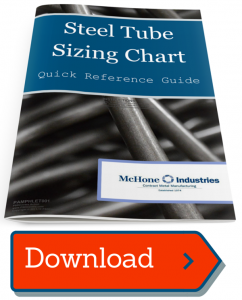If you need pipe or tube bending services, there's probably a bending company in your area that can pull it off. But just because a bender can meet your specifications doesn't mean you should order off the cuff -- at least not if you want to keep costs down. Fortunately, there are easy ways to save money on CNC bending.
Let’s take a look at some of them here:
8 Tips to Keep CNC Bending Costs Down
1. Use the most common material size possible.
Some material is much more expensive because it is rarely made. Talk to your tube and pipe supplier about which sizes of materials are the most cost-friendly and try to stick to those when ordering.
2. Choose welded material if you can.
A skilled bender can often create the bends you need using welded material -- which is almost always cheaper than seamless material. Not all applications will allow for welded material, but if yours will you can expect to save some money.
3. Allow for sufficient bending tangents in your order.
Bending tangents are the straight pieces of material that begin where the bend ends. In most cases, for a pipe or tube to be bent, it must have enough tangent material on each end for the machine to apply the required force to facilitate the bend. If a pipe does not have sufficient tangents, they must be welded on to complete the bend and then removed afterward.
When you order material to be bent, be aware of the tangents needed to complete the job. If your order doesn’t require tangents to be added and/or removed, it will cost less.
4. Avoid minimum charges.
Most benders have a minimum order size that they prefer. If you order less than the minimum, you will incur charges. Ask the bender about minimum charges and see if you can order enough to avoid wasteful spending.
5. Ask for a different bend end preparation.
Some bend end preparations cost more than others. If you are not particular about the preparation you need (Perhaps it will be removed by the fabricator that receives the material next?), then you can simply ask for whatever is least expensive.
If you require tangents on the material, try to request a minimum length instead of an exact length. This gives the bender the option of choosing which is easiest and least expensive.
6. Choose a common radius.
You can request just about any bend radius you prefer, but some are easier to accomplish than others.
This is another area where talking with the fabricator can help. Know which measurements you need for your application, then speak with the bender about which common dies would fit your needs.
7. Let the bender figure out the shipping.
Specialized shipping for unique bends and material sizes can get expensive quickly.
Instead of trying to figure it out for yourself, have the bender arrange the shipping. The bender will know how to keep shipping costs down and how to package the material for the most secure transport.
8. Talk to the bender.
The bender you choose to work with should be best equipped to examine your needs and advise you on where to save money. Some deals may be more obvious. But other cost savings may not be apparent until you have a detailed conversation.
There are full-service vendors who can help you with each stage of the manufacturing process, from design to shipping. In other words, they’re used to optimizing designs to cut costs.
Helping You Save on Fabrication Costs
It may seem unusual, but there are metal fabricators that want to help you keep costs down!
By keeping CNC bending costs down for you, they’re usually trimming their own operating expenses, too. Find an experienced, full-service vendor with a track record of cost efficiency.



